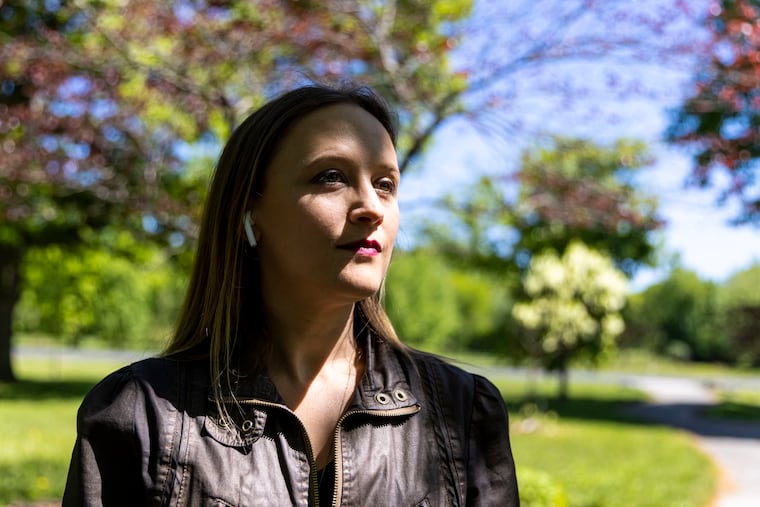A walk in the park at Fairmount Park now comes with a musical soundscape
Ellen Reid's "Soundwalk" arrives as a powerful piece of art for discovery and self-discovery.

When you walk away from the Mann Center these days, the music follows you in gently transforming ribbons of sound.
Down a knobby hill of white clover, as you look over the treetops of Fairmount Park to the city skyline, the soundtrack signals civic pride and promise.
Jazzy drums, piano, and trumpet riffs take over at the traffic circle anchored with white marble statues.
On and on, down a tree-lined path, the world seems to open up: warm strings, the smell of freshly mowed grass drying in the sun, a glistening harp, sweet pine perfume.
This sequence is something you yourself might never be able to experience — not exactly. That’s because Ellen Reid’s Soundwalk comes together as a different piece of composition/sound sculpture every time a listener hears it.
And a gorgeous piece of public art it is.
Download the app, put in the earbuds, and walk. The rest is up to chance. Depending on your pace and an infinite number of paths through a roughly 280-acre patch of land around the Mann, Horticulture Center, and other sites, the piece materializes in an infinite number of forms. The GPS-enabled app responds to location with a continuous swath of changing recorded music and sound.
Reid, a Pulitzer Prize-winning composer who splits her time between Los Angeles and New York, had never been to Fairmount Park before this project. Soundwalk premiered last year in Central Park with its soundtrack recorded by a freelance ensemble, including synthesizer, and members of the New York Philharmonic. Fairmount Park’s version uses mostly those same freelancers, with some added sound recorded by 19 members of the Philadelphia Orchestra at home.
The work here is being presented by the Mann and Fairmount Park Conservancy, and part of the point is to familiarize Philadelphians with what lies just beyond the music center, Please Touch Museum, and other discrete destinations. Many drive in, hear a concert, or take in the children’s museum, only to leave without engaging with the larger setting.
For me, Reid’s piece was a chance to discover, at least from the outside, the Ohio House, a ghost of the Centennial Exposition held in the park in 1876. It sits close to a Mann entrance, but is a structure I’d somehow missed all these years.
Longtime Mann president and CEO Catherine M. Cahill told me she had known of the statue of Verdi in the park, but until now not about the ones of Schubert and Haydn.
Fairmount Park has a music all its own. There is birdsong, wind, and water, of course, but also traffic, the thumping of car radios, and in some spots the whoosh of the Schuylkill Expressway. The natural and man-made worlds coexist and fuse in fascinating ways, and Reid’s music gives us a structure on which to hang discovery.
But Soundwalk is more than permission to stroll. It’s surprisingly emotional, and it somehow recasts Fairmount Park anew.
A walk up to a medium-sized oak a couple of weeks ago came with a faint, sweet smell of smoke and equally mysterious music. Nearby, something more industrial presented itself: a series of giant spools holding hoses that mirrored the spiraling arpeggios of Reid’s music.
It wasn’t intentional or planned. Most of Reid’s musical material is shared among the co-commissioners: the Mann/Fairmount Park Conservancy, New York Philharmonic, Saratoga Performing Arts Center, Wolf Trap Foundation for the Performing Arts, and the Britt Festival Orchestra in Oregon. (Soundwalk has popped up at other sites nationally as well.)
There’s nothing literal or programmatic in the matching of sites and music. In Fairmount Park, standing before Henry Baerer’s bust of Schubert doesn’t bring your ears a passage from a sparkling Impromptu, and walking beside Concourse Lake won’t trigger anyone’s Water Music.
But that’s part of the message. Music colors location, location suggests a meaning to the music, and anything is possible. Reid’s partially acoustic, partially electronic music takes some inspiration from Brian Eno and John Luther Adams, she said on a recent walk-through of the piece. It is both atmospheric and quite affecting.
Soundwalk may be aleatory by nature, but it lands in Philadelphia at a specific moment in time.
“When this was being conceived, it was very unclear what the future would hold. No one had a crystal ball on where the pandemic was headed, and there were some very dark days,” says Cahill.
It’s no accident that Soundwalk is partially funded by Mindscapes, a mental health program of Wellcome, the London-based foundation concerned with global health. It’s been a noisy and traumatic few years for most of us. Pandemic and politics have crowded out a sense of well-being. Soundwalk arrives as COVID-19 appears to be on the wane and we are getting back out into the world.
Regardless of era, Soundwalk changes our perceptions of the park and what’s possible there, and refashions sound and environment into a space for interior revelations. It’s a reminder of the core work of artists — rerouting our thoughts, feelings and memories. The piece can be experienced in an hour or five, and it works beautifully to help us process everything that’s happened and is happening.
It can also help us forget, if only for a precious slice of time.
Soundwalk runs in Fairmount Park from June 4 to Sept. 30. For more information and to download the app: ellenreidsoundwalk.com.